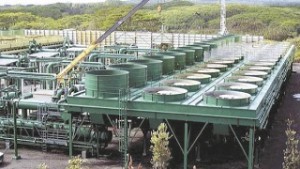Geothermal: Making Progress in Tough Terrain (figuratively and literally)

As part of my first book, Renewable Energy — Facts and Fantasies, I interviewed Ormat’s spokesperson Paul Thompsen, who impressed me not only with his deep understanding of the subject, but also with his sense of awe he conveys regarding the entire enterprise of geothermal. In many ways, constructing geothermal plants is the precise opposite of that of oil and gas exploration. While it’s true that today, the most accessible pockets of fossil fuels have long since been exploited, oil companies are still drilling through some of the easiest, sandiest materials on Earth. The precise opposite is the case with geothermal; they’re drilling through the most difficult material in the Earth’s crust, with no way to know in advance how well their holes are going to perform.
Still, the technology has plenty of appeal, particularly in regions that have huge, easily-accessed geothermal resources, and/or regions in which few other alternatives exist. Those looking for baseload power are automatically interested; the power coming from a geothermal plant is delivered 24/7, and is sold as if it were coming from a coal or nuclear facility.
(pictured above: Hawaii’s only geothermal facility)

Geothermal is not just for large commercial/municipal projects either, there are residential applications as well.
Surely it would be good for research on geothermal energy to continue. Research is require for a number of reasons before geothermal could become practical on a large scale. It has already been demonstrated to be possible.
The water drawn up from geothermal wells tends to be heavily loaded with corrosive substances. The corrosion problem is exacerbated by the high temperatures. Corrosion resistant materials must be found.
Over time, in some areas the reduction in temperature as more heat is withdrawn is likely to be a problem; already there is some evidence of that. That could be area-dependent and not a problem in some areas.
Compared with other power generation technologies which use heat engines, the available temperatures with geothermal systems tend to be much lower. That means that turbines would have to be larger to compensate for their lower efficiency thereby increasing costs.
It may be that with sufficient R & D geothermal power could become practical in many areas, but it’s not yet ready for prime time. If history repeats itself, we may terminate funds for geothermal power R & D prematurely just as we terminated funds for R & D to develop better nuclear technologies.
Frank I am a little surprised at your suggestion that geothermal may someday be “practical on a large scale,” and is “not ready for prime time,” when I look at this list of over 90 commercial geothermal powerplants world wide: http://globalenergyobservatory.org/list.php?db=PowerPlants&type=Geothermal
With respect to the heat the industry expansion seems to be working from the middle to the extremes. Recently in the news is a new geothermal plant that has drilled down to find a magma heat source: http://futurism.com/geothermal-power-a-breakthrough-straight-into-the-volcano/
We also find technology exploring “dry well” geothermal. The name comes from applying this technology to old oil wells. You will also see the terms “hot dry rock” or Enhanced Geothermal (EGS.) To get usable heat from such a low heat source a heat pump system is used. http://www.energy.gov/articles/googleorg-backed-potter-drilling-blazing-geothermal-trail In this such systems are similar to the geothermal (ground source heat pump) systems used for residential and industrial heating.
Geothermal systems also offer the highest capacity factor of any renewable energy type, similar to the 90% that we find with nuclear energy. However there do seem to be ongoing challenges for geothermal efficiency is increased through the use of fracking. Well cost is a significant factor but there are now two interesting alternative methods (laser & hot water) to drill wells. The needed wells can destabilize ground structures leading to earthquakes. Water supplies may be required for injection wells and for cooling. In volcanic areas steam will tend to come with chemicals that need to be removed.
Closed cycle turbines using super-critical CO2 would overcome the need for larger turbines.
Gary,
You seem to be referring to the closed Brayton cycle. If the Brayton cycle would have advantages I don’t know why it is not used in coal burning plants. The open Brayton cycle is used in some gas burning plants in which the waste heat therefrom is used to drive a Rankine cycle.
The critical temperature for CO2 is only about 88F.